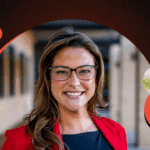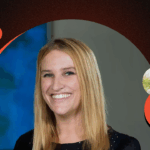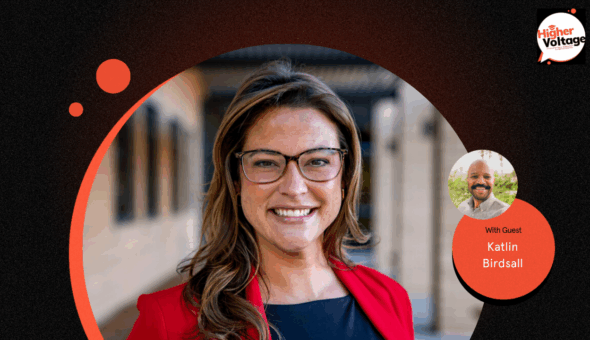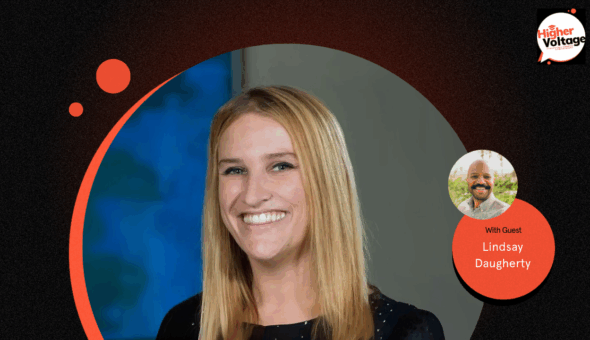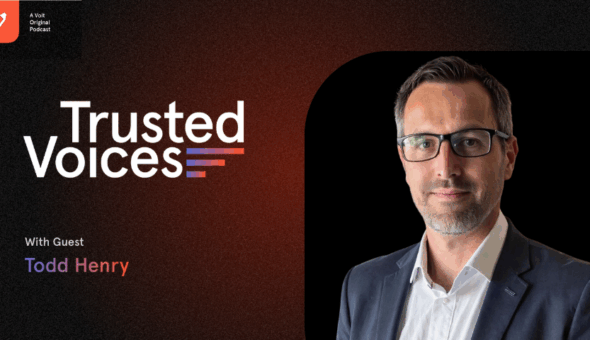As digital accessibility becomes a growing priority in higher education, new updates to Title II of the Americans with Disabilities Act (ADA) are pushing institutions to move from reactive fixes to proactive compliance. Kevin Tyler welcomes Jamie Axelrod, former president of the Association on Higher Education and Disability and current director for disability resources at Northern Arizona University, to discuss what these changes mean for colleges and universities. From the legal implications of non-compliance to the importance of universal design, they explore how institutions can create a more accessible digital landscape—one that benefits all users, not just those with disabilities.
Show Notes
Discussion Points
- Colleges must revise millions of web pages. It will be painful.
- University of Iowa creates task force to update digital assets for accessibility
- ADA Fact Sheet: New rule on accessibility of web content and mobile apps
- BGL team secures $240k for blind students in discrimination lawsuits against LACCD
- Harvard ramping up captioning efforts with National Association for the Deaf settlement
Read the full transcript here
Kevin Tyler
Welcome back to Higher Voltage, everyone. So glad to have you join us today. I’m excited to continue our series around technology and innovation in higher education. Today, I have joining me Jamie Axelrod. Jamie is the former president of the Association on Higher Education and Disability and currently serves as the Director of Disability Resources at Northern Arizona University. Jamie, welcome to Higher Voltage.
Jamie Axelrod
Well, thank you. Thanks for the invitation. I’m really excited to be here.
Kevin Tyler
So we are talking today because late last year, think December it was, there was an article posted on the Chronicle of Higher Education titled, Colleges Must Revise Millions of Web Pages and in quotes, it said, “It Will Be Painful.” And all of this stems from some updates to the Americans with Disabilities Act, Title II of the Americans with Disabilities Act, that is dictating some updates that colleges and universities will have to make to their websites. I’m curious if you can just share kind of an overview of what those updates to Title II of the ADA are and what that means for higher education.
Jamie Axelrod
Sure. You know, Kevin, just before I do that, I want to make sure that I share that the opinions I’m going to share with you today are just my opinions. They don’t necessarily represent my institution, but my opinions as a private citizen but someone who works in this area. Talking about the specifics in terms of the changes to Title II, I want to first highlight that these changes that were made or that were incorporated within Title II this last year were also incorporated into the Section 504 regulations for the Department of Health and Human Services. And I think that’s an important thing to highlight because Title II of the Americans with Disabilities Act covers public entities, right? So government entities, but it doesn’t cover private entities, places of public accommodation, like private universities; those are covered by Title III of the ADA. However, many private institutions receive federal funds through HHS, Health and Human Services. And so these same rules currently would apply to them as well. So, with that aside, the additions to the Americans with Disabilities Act related to the accessibility of digital content really come in a new section that was added, subsection H. And in an area where things can be highly technical, the rule itself is actually fairly straightforward, right? So, almost all of the regulations come with a general requirement, and this section is no different.
And so the general requirement, which kind of outlines like, what’s the purpose of this new rule? Basically says that public entities need to ensure that the technology that they’re using is readily accessible to and usable by individuals with disabilities. And it highlights web content that that public entity provides or makes available either directly or through a contractual or licensing agreement with some third party, right? So, the public entity is still responsible. And any mobile apps that the public entity uses and makes available, again, you know, either something they develop themselves or that they’re contracting with a third party to provide. And then what the new regulation does is it sets a technical standard, right? Previously, there have been a lot of discussions about the general requirements of non-discrimination under the ADA really sort of covered your digital programs. But a lot of folks would argue, well, there are no technical standards, right? We don’t know what the standard is that we need to comply with, what is accessible. And so now this new regulation sets that standard, which is an adopted standard, which we’ve seen in a lots of court settlements.
It is the World Wide Web Consortium Accessibility Guidelines 2.1 level AA. So there are three levels to those, AA and AAA. And this adopts that WCAG 2.1 level AA standard. And in that, those are the primary affirmative requirements of the regulation itself, right? Pretty straightforward. Here’s why we’re doing this. Here’s the technical standard you need to meet. And then it provides a timeframe for compliance or conformance. And that timeframe, because Title II covers all government entities, right? It doesn’t just cover higher ed, public higher ed. It covers your local community. It covers your state government, federal, right? So, it covers all kinds of public entities. And in that sense,
The requirements are based on population. So, if your entity serves a population that’s greater than 50,000 people, you have two years to come into conformance. If you serve fewer than 50,000 people, then you have three years. Now, at the start, many schools and colleges were a little confused about that. And they thought, well, we don’t have 50,000 students.
You know, so we’ve got three years. No. You know, I work at Northern Arizona University. The population that Northern Arizona University serves ostensibly through the state is whatever million. And so, right, we have two years because we’re over 50,000.
Kevin Tyler
I really appreciate that breakdown and the detail that you provided in that breakdown because I think it gives people an idea of where to look for the updated text of the ADA. But also, it gives people a sense or a reference point of why it’s happening. This is not a new kind of requirement, right, digital properties have long been expected to serve all types of different abilities. And so this new rule is forcing essentially institutions to take a more proactive approach to that. We have a history in higher ed to be a bit reactive. And so now we have this law, this rule that is being enacted that will make institutions come into compliance by, I think, 2026, depending on exactly what you said about how many folks are being served.
This is going to take a bit of a culture shift, right? And that’s what this article kind of talks about in the Chronicle about a culture shift needing to happen from moving from a reactive kind of space into a proactive one. And I’m curious if you can share any sort of advice around coming into compliance for institutions, what to consider, what might make this a bit more smooth than what is expected the experience to be right now.
Jamie Axelrod
Yeah, I mean, I think it is to me; there’s a real focus here on universal design. You know, the regulations could have taken a different tact when it comes to digital accessibility. And, you know, the Department of Justice, in my opinion, you know, to their credit, took more of a universal design tech. And one thing I can share about that, that sort of points to that, is there are exceptions to this technical requirement, right? And we could get into those if necessary. And in fact, a lot of the regulation itself is kind of focused on what those exceptions are. But when the rule was first announced in its proposed rulemaking, when there was a public comment period, there was an exception for instructional materials that were behind a login, right? So, like in a learning management system, only students who are enrolled in that class have access to those; they could log in. There was an exception in there for that type of content. And the exception gave some timeframes by which a university could take a reactive approach and say, well, we have a student in that class who we know needs the materials to be accessible. And so you have this amount of time, right, to get those things accessible. And based on that public comment period, the final rule actually removed that exception and said, no, based on public comment and our understanding of those comments, we’re removing that requirement, that exception. And we are going to say, on the day that those materials become available, they need it to be accessible from the start. So, in a sense, the rule itself is building in a bit of a culture shift and helping higher ed get away from that reactive mode. And, I think, even in the section-by-section analysis that was provided by DOJ, you know, they talked about that in the end, they understood that reactive mode isn’t really going to be effective for those students who are in those courses, right? So if a student arrives and they don’t have those materials for two weeks, given this exception, and there’s still this reactivity, then they’re at a distinct disadvantage. And that’s not the type of access that’s wanted to be provided. So, in a sense, the rule itself is building in some of that, some of that culture change within the framework of the design of the ADA to ensure effective access, right? So, your real question was, what are steps that folks could take on campus, and what do they need to do? And I think because it is a culture shift, schools really need to think about planning their approach, right? Knowing that this is coming, sitting down and having some really well thought out strategic approaches to making these changes, right? As the article identified, this is for many places, this is going to be a big lift. Some institutions have structures in place already to help with this type of a lift. They’ve been doing this work for a while, working on this shift and others don’t, you know, and they’re not prepared. I think it’s critical that campuses identify, well, who are the key stakeholders and partners that we need to have at the table, to be able to implement this kind of shift, address the issues that we have in our digital content, and take the steps necessary, right? And once those stakeholders are brought together, having a way to identify, what is the scope of this for us. The article identifies that there are millions of web pages. Well, for some places, the scope of the task may be greater or lesser, depending upon the work that they’ve been doing and what they already have in place. And then, to create a strategy and prioritize sort of their efforts towards achieving this. Look, I mean, people have to be realistic. People have to have some concrete objectives that they’re shooting for. And while they need to be realistic, I think they also need to be somewhat idealistic in addressing the community, right? There are a lot of folks in a campus community that play some sort of a role. And many campuses, their digital environments are very decentralized. You know, whether it’s your public-facing web presence or whether it’s your course content and a learning management system, much of that can be really decentralized. And on some level, in getting together with those stakeholders, identify what are our methods for holding people accountable. How are we going to do that? What tools and resources can we provide to the folks who are going to be responsible for ensuring compliance? Some aspects of reaching these WCAG 2.1 AA standards are straightforward and fairly easy. Some others may be more difficult. So helping people have the tools necessary to be able to get to conformance is going to be really critical. One thing I’ve experienced in my time in the field is that when you sit down and talk with folks about the idea of digital accessibility, there are really no one in the room who doesn’t agree with that.
Kevin Tyler
Right. Right.
Jamie Axelrod
And so people get that. But when the rubber meets the road and individual people are required to do things to achieve that end, then it can be a little bit more difficult. Especially when people, not everyone has the technical skills and abilities on hand, right, to do that themselves. So how do you support people and provide them the resources they need?
Kevin Tyler
Totally, totally. I’m curious if you know the answer to this. If not, totally fine, but as of today, this rule still stands, right? It’s still intact, even in the change of administration and the timeline remains the same and the new cabinet member of HHS and RFK Jr. This rule has been untouched so far, correct?
Jamie Axelrod
So when it comes to the ADA regulation, that regulation is published, and it is out there. So that’s really a DOJ conformance piece. The Section 504 regulations that were issued through HHS that we said right at the start would capture those private, there are currently challenges to that rule. The challenges aren’t necessarily about the digital accessibility aspect of the rule. It’s about some other things that were included in that rule. Those legal challenges were launched prior to the new administration. They were launched last summer. So if those challenges were successful, the new rule could be put on hold, or it could go away, and we would revert back to the prior HHS rule, which didn’t have any of these digital accessibility requirements to this kind of technical standard.
Kevin Tyler
Okay, that’s helpful. Thank you so much.
TVP ad read
Kevin Tyler
One of the things I think about when I hear about these updates having to be made are all of the projects I’ve had in my career in higher ed marketing and branding where we would discover, you know, a faculty member of geology had set up their own webpage somewhere that is serving students, but might not be either plugged into the main site or is some other property on its own. Do you know if there’s A, any governance templates that exist now, and if those types of pages that might not be connected to the institution’s main site but is used to serve students, is that all included here?
Jamie Axelrod
Yeah, it is all included because, remember, part of that rule was, well, maybe it’s a digital asset that’s being used through contractual or licensing or other arrangements, right? And it is true, especially on campuses that are very decentralized and don’t require the faculty to use the technologies that the institution is providing for them, and they go outside, they create their own website, and I’m gonna conduct my course through my own separate website, right? Well, you’re still requiring students to engage with a digital asset.
Kevin Tyler
Exactly.
Jamie Axelrod
In order to participate in the program being offered by the institution, right? So, it is captured in that requirement. So, in the exceptions, there’s an exception for third-party content. And so there was some confusion about that from the start, like, oh, well, that means anything that we bought from someone else or anything that, you know, is directing someone to some someplace else, then we don’t have to worry about that. But again, the department was pretty clear in the rule, right? Contractual licensing or other arrangement and in the section-by-section analysis describing that the DOJ was really clear to identify what that means, right? So it says, if you’re using that third-party content in order to run your programs and someone needs to engage with that third-party content in order to participate in that program or benefit that you’re offering, then that is covered, and that is on you. And I think this is one of the places that schools are going to have of some particular difficulty with is going to be third-party courseware, right? Or add-ons or things that come with digital tech associated with digital textbooks. So those places where students go to do their homework or maybe take a quiz, and it’s provided through one of these third-party systems, right? Generally, we call them courseware. Because if you’re not paying attention and evaluating the accessibility of that third-party courseware, you don’t have a lot of power to go in. It’s not your own content. You can’t go in and address that.
Kevin Tyler
Right.
Jamie Axelrod
You can’t go in and fix it. You’re reliant on the publisher or the entity that is providing you, but you’re going to be ultimately responsible. So that’s an area that kind of keeps me up at night. How do we get a handle on all those types of third-party tools? Because a faculty member uploads something that’s not accessible in an LMS, we have much easier ways to access that and capture that and fix that.
Kevin Tyler
Right.
Jamie Axelrod
Whatever XYZ publisher who’s providing this courseware that goes along with their digital textbook, that’s much more difficult to address after we’ve implemented it.
Kevin Tyler
Yeah. It sounds like the PDFs that higher ed seems to rely on are going to be need to be updated in some way.
Jamie Axelrod
Yeah, PDFs are, you know, a really sticky issue that we’ve been dealing with for a long time. Digital accessibility is achievable in PDF, but you really need to be skillful at using Adobe tools. And then, most people who use and create PDFs aren’t doing it in that type of way. They don’t necessarily have those skills anymore. And we’re converting lots of documents into PDF format. So, right, the accessibility is not there. And yes, there are many schools, especially on their public-facing site, who are taking the tact that like, hey, we’re not going to host PDFs anymore, right? Let’s talk about what other options we have. And in fact, in my own experience, so much of what people put in higher ed, at least on a public-facing website in PDF format, could really just be a webpage, you know.
Kevin Tyler
If it needs to go in there at all.
Jamie Axelrod
If it needs to go on there at all, because you know, secret, sometimes the website turns into a junk drawer for everybody’s documents that they want to store. They’re not sure where to store them. So they just like, I’ll put it up on the website.
Kevin Tyler
That happens in higher ed? I’ve never… I’m just kidding.
Jamie Axelrod
But having governance tools in place, right? You know, how do we have governance tools to monitor those things, to address those things? That is part of bringing the stakeholders together, you know, identifying what’s the scope of the task and then what tools do we have available to us to help manage that?
Kevin Tyler
Yeah, I think one of the unintended, maybe intended, benefits of all of this is an increase in the fluency around accessibility, especially in digital spaces. I do, though, worry about the investment that work like this might require, right? There will be some folks, or some institutions, I should say, that will have to invest quite a bit of money just because of the size of the sites and how many pages and what needs to be done to update, to come into conformance, and others less so. And so I’m curious, so we have, for example, University of Iowa has created a task force recently to address these new updates to the ADA. And there will be places that can do it internally and some that can’t. And so I’m wondering if you have any perspective or opinion about this adding to what some consider more bloat in higher education, more operating costs, but it’s such an important investment to make. Do you have any thoughts on that?
Jamie Axelrod
Yeah, I mean, I think that there will be an initial large investment that a lot of institutions need to make. And, you know, I would also say there are a lot of institutions that have been working on this for quite some time.
Kevin Tyler
Of course.
Jamie Axelrod
These are issues that have been identified by the National Federation for the Blind and OCR and the DOJ, going back to the early 2000s. And so a lot of schools that were paying attention or had the capacity have really been paying attention to this mostly on their public-facing website side, right? But they likely have very skillful folks who are already there. They have processes and resources in place that they can expand out. And so there will be some initial buildup that is required. But I do think that once that design structure and that understanding and that literacy is elevated, the ongoing monitoring, which will be required, right? I mean, a web environment is very dynamic. You know, there are lots of changes happening all the time in a web environment, especially with lot of people who have access to it or can contribute to it. So, I think there will need to be some ongoing investment for schools that don’t already have, like say, an accessibility analyst type position or workflow in place to have tools and have some staff who are responsible for that monitoring and oversight. And so, in the longer term, I think the investment will be able to be reduced once conformance is achieved. Now, you know, on the academic side of things, I think that lift will be heavier for the LMS kinds of content. But I’m hopeful, I’m optimistic. I am hopeful that our partners, who provide faculty members instructional materials, right, which are often the culprit or those coursewares that we talked about, that people will start to come to understand that, oh, if I want to be engaged in the higher ed space, I’m going to need to provide people accessible content. And that that will spill over into publishing workflows and digital design kinds of workflows, and more of those third parties will also become more fluent in designing things digitally. We’ve seen lots of improvement.
And one of the reasons I’m hopeful is that just this past summer, the European Union implemented very similar requirements for instructional digital materials. And I’m sure you know that in the higher ed space, many, if not most of the publishers that folks use are multinational, right?
Kevin Tyler
Right.
Jamie Axelrod
They’re not just U.S. entities. So my hope is that all of the changes that those publishers and creators have made to be able to stay engaged at institutions in the European Union will take that experience and apply it here as well, right? And hopefully there won’t be like, well, these are the EU version of these products and here’s the US version of these products. I think it’d be easier for them to just go, here’s the product, right? And so I think there’s some broader, you know, support for those instructional materials to come into conformance and to do a better job.
Kevin Tyler
Do you have a sense of what the consequences are for not coming into conformance by the deadline?
Jamie Axelrod
Well, I think there will be initial consequences in terms of advocacy organizations enforcing compliance through legal action. I mean, I do think that’s almost a guarantee.
Kevin Tyler
Yeah.
Jamie Axelrod
And when advocacy agencies do that on behalf of group of individuals or specific individuals, then there may be some additional kinds of costs associated with that. But, you know, for the most part, government agencies, and we’ll see what exists of those government agencies when the time comes. Their enforcement is mostly going to be injunctive relief, right? I mean relief that’s designed to fix the problem and get institutions to come into conformance. Now, that’s costly. Like, just like we say, if there’s going to be a big investment for folks who are doing it proactively and on their own and going like, right, you know, we need to do this and it’s the law and it’s the right thing to do for our students who we’re inviting to our institution. And we’re going to need to make this investment, you know, waiting to get sued or to have an enforcement action. Now you’re going to need to do that all on someone else’s timeline, right?
Kevin Tyler
Right.
Jamie Axelrod
And to someone else’s standard, and likely there’d be some sort of a settlement agreement. And now you’re not necessarily in charge. You’ve got others telling you, is how we expect you to do this beyond just right, what the straightforward kind of regs says. So, I think that’s the primary concern, you know, for schools who are not taking this seriously and doing the sort of proactive work is doing it on someone else’s dime on someone else’s timeline. And maybe in a way that even goes beyond what is required by the regulation. Now, you know, the DOJ, if they were to do enforcement actions, do have the power to fine institutions. I think, you know, their first step would be looking for injunctive relief and getting schools to fix their digital assets and bring them into conformance.
Kevin Tyler
Yeah, I think, I mean, as long ago as 2019, we saw, you know, Harvard, you know, having to take care of captioning efforts after a lawsuit was brought to them from the National Association for the Deaf. And they not only obviously had to make the investment of the captioning for all of their video content and web digital content, they also had to pay the legal fees for the plaintiffs, which totaled 1.6 million dollars. Now, Harvard has, you know, 1.6 million dollars to do, but not everyone has that. And even the Los Angeles Community College District had a lawsuit leveled against them for blind students, and the total payout there was $240,000. So, there are big dollar amounts that are associated with making these updates that can be avoided if you make the investment proactively, it sounds like.
Jamie Axelrod
Oh, absolutely right. I mean, like things like expert fees and legal fees, you know, those are all things if you choose to go to court, right? Harvard, that was something they agreed to pay in their settlement, right? That was when you didn’t even go to a jury. And the LACCD case, unfortunately, some of those awards are still being appealed and argued back and forth in the district court that heard that reduced some of those fees down quite significantly. But LACCD and the particular colleges involved, like you said, right, you know, there’s a big lift there still. So, yeah, absolutely, when you kind of wait for someone to sue you or some sort of an enforcement action, right? All told, you may not be paying a lot of money directly to a student, but all told, there’s a lot of costs for that. And, you know, and as we said before, or as I mentioned before, this isn’t just the right thing to do. This isn’t just a legal requirement, excuse me. It’s really the right thing to do for the members of our community who we’re here to serve, right? And who we’re here to educate and who we’ve invited to come and benefit, and most folks in higher ed have a mission to educate those who come to them and want to do that effectively. I mean, a good example of that is at our institution, we use an accessibility system within our LMS called Ally. And Ally does a number of different things, but one of the tools that it provides to end users is to…it can enhance the accessibility of documents that are in the LMS by creating alternative formats of those for folks. So maybe there are specific accessibility issues with that type of document, and this tool can be used to convert that untagged PDF into HTML, right? Or into an EPUB3 or enhance the accessibility that way. And maybe at our institution, we have 200 or so students that we know need those materials in a specifically accessible format, right? In order to engage with them. Okay. And we’re working in many ways to provide those to those students. But if, when I go in and I look at, who’s utilizing Ally to download materials in alternative formats. I see that in a typical semester, 19,000 different, unique users have downloaded close to 100,000 versions of things in the LMS in an alternative format.
Kevin Tyler
Wow.
Jamie Axelrod
That’s telling me, whoa, this is a really helpful tool for a lot of people. And, maybe, some of those folks are students with disabilities who need those materials that way and now can just get them, right? They don’t need to take other steps to self-identify to the institution and work with the disability research. They actually have what they need just through the LMS. That’s probably some portion of those students. But then there’s lots of other individuals who find having materials in a more accessible format is helpful for them for whatever reason that is helpful. And so, I always look to that to say, wow, here’s a universal design sort of playing itself out and why having digital assets that are more accessible and usable benefits a very broad variety of people in our community.
Kevin Tyler
Yeah, and I couldn’t agree with you more that, yes, it’s a legal requirement, and yes, it’s definitely the right thing to do. I think the other part about this is that there’s a bit of a reputation issue here, right? We cannot market and message around all are welcome here. You know, we are here for everyone when accessibility is a challenge for a proportion of an audience, right? We have seen videos on TikTok and other social media platforms of folks who need accessible entrances, that they were told that the buildings had accessible entrances, and they arrived to campus and that was not the case. And so there is a reputation play here that is important, right? We get people to our campuses, and whatever part of their educational experience ends up not being as accessible as it was promised to be, then we’ll have a retention problem, right? And so I think that, yes, it’s the right thing, but there are some other benefits here or considerations to make as well.
Jamie Axelrod
Yeah, absolutely. Right. You know, I couldn’t agree more. That’s really what it’s, what it’s about. And in some ways, that’s why, you know, for me, personally, the DOJ’s decision to take a universal design approach to this regulation is really in the end, going to sort of change and reframe that culture of digital accessibility down the line for sure.
Kevin Tyler
Yeah. I’m curious if you have any opinions about the advancements in technology that might help with compliance and accessibility in the space.
Jamie Axelrod
Yeah, I mean, I think that there’s a likelihood that AI and improvements in AI will make achieving this more feasible. Look, there have been automated systems, right? AI, in essence, for enhancing accessibility and identifying accessibility issues and remediating those. And, you know, they’re okay. They help out. They are not reliable in a way that you can go, we have these products and they make everything accessible, so we’re good to go. And we don’t have to worry. I mean, they just don’t function that well. And everything takes some manual evaluation and potentially human intervention, especially with those PDFs, right? Like that you were talking about earlier. So I do think that the likelihood is that AI will really enhance the ability to use technologies to more quickly and effectively address digital accessibility. You know, we’ll have to see where that goes.
Kevin Tyler
Of course.
Jamie Axelrod
And how quickly that develops. But I do think technologies are in play right now, and they are helping, and that will continue, that will continue. Yeah. I mean, when I think about back in the day, when providing accessible materials to folks who were, let’s say, blind and were Braille users, right? It was like, hey, we got this figured out. Like we make stuff in Braille.
Kevin Tyler
Right.
Jamie Axelrod
It’s all physical stuff and we make it into Braille. And interestingly enough, as things went digital, when people were thinking, this is going to be better for everybody to make things digital and get away from hard copy. Those accessibility challenges that we had for, especially, say, the blind, visually impaired community, they actually took a hit.
Kevin Tyler
Totally.
Jamie Axelrod
Because people weren’t thinking about it proactively, right?
Kevin Tyler
Right.
Jamie Axelrod
There was this kind of benign neglect around access in that space.
Kevin Tyler
Interesting. And my final question, which is a question that I ask every guest that joins me on Higher Voltage, is, what do you think higher education will look like in 5 or 10 years?
Jamie Axelrod
Yeah, I, gosh, right now, with everything that’s going on. I think that is such a hard question to answer.
Kevin Tyler
Yeah, I know.
Jamie Axelrod
You know, last year I would have said that I think our environments will continue to grow with that we will continue to see, you know, lots of competition from credentialing and other kinds of educational opportunity or, you know, what people might consider professional development, other ways into the world of work or fields. And I think that’s likely still true. I think higher ed will continue to remake itself in relationship to, sort of, the enrollment cliff, you know, that’s here and will continue. So, so institutions will need to address that and understand how do we deal with that? Do we keep going after this elusive, increased enrollment? Or do we turn some of our focus inward and say, how do we better retain the students that we have, right? That is a way forward. I think we’ll see some continued push to make higher ed opportunities more broadly accessible, not in the disability access terms.
Kevin Tyler
Sure.
Jamie Axelrod
But in terms of broader terms, whether that’s financially more accessible or the requirements for entry to be more accessible. I think we’ll continue to see that expand, people trying to expand the opportunities for folks to get involved in post-secondary education. And I do think we will start to see the digital space become more equitable for all folks and folks with disabilities in particular. I think we always have to be mindful, though, that with changes in technology, lots of times when we chase that shiny new object, we do that benign neglect thing. And we don’t think about everybody who we’re going to offer this to. And I’m hopeful that much of that will begin to change, especially in a higher ed environment. And, yeah, but I think we’re going to have to wait a little bit to see how things play out in the next few years in relationship to what role is the federal government going to play in, you know, ensuring access in post-secondary environments.
Kevin Tyler
Yeah. Jamie Axelrod, thank you so much for joining me today on this next episode of Higher Voltage. It was a privilege and informative to chat with you. We will have the article from the Chronicle and a few other resources on the episode page. But in the meantime, Jamie, thank you once again for joining me.
Jamie Axelrod
Oh, thank you so much for having me. It was a pleasure.


